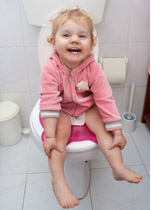
 Toilet Training Toddlers
Toilet Training ToddlersFoster the support of parents to ensure a consistent approach
As with all aspects of child care, providers have different policies on toilet training. For many children starting in care, being in the company of children wearing underwear serves as a great motivation to toilet train, for other children it makes no difference!
Whatever your service's policy it is important to foster the support of parents to ensure you have a consistent approach. Using the same forms of equipment, encouragement and praise will bring faster results and reduce the trainee's confusion.
Points to consider when considering toilet training:
Timing
It's best not to start toilet training just before/during or just after a big life event, including birth of a sibling, moving house, divorce, big trip etc. Seek the parents advice on this matter and make sure you gain their consent before embarking on a toilet training regime.
Equipment
Most child care services have child sized toilets but family day carers may use potties or regular toilets with a potty seat on the top. Parents should be made aware of the equipment being used in your service. Children are flexible and will be able to switch between what is happening at home and what is happening in child care, however it is useful to have the same rules surrounding how the equipment is used, for example how long the child should sit, washing hands etc.
Nappies vs training pants
Opinions vary on how long children should use nappies and if and when training pants (or pull-ups) should be used. Once the parents have given their permission (and lots of spare pairs of underpants) most service providers seem to prefer to remove nappies. Constant prompting and the company of other children training at the same time seems to work for many children. The process can be slowed if parents keep their children in nappies at home.
Naptime
The occasional accident at naptime may further encourage children to understand the outcome of not going to the toilet before sleep time. Children who have accidents more often than not should possibly be put back into a nappy for sleeps until a later date. Make sure you have easy to clean sheets, hammocks etc to reduce the workload resulting from these accidents.
Practical clothing
Make sure you ask your children's parents if you would like to start toilet training their child, explain your strategy and remind them how important it is to dress their child in practical clothes. Clothes should be easy to remove quickly and children should be able to pull them down/up on their own. Parents should also be reminded to provide at least two additional sets of clothes and lots of extra underwear.
Make sure you inform parents about your policy on laundering wet/soiled clothes. Remind them to check their child's bag at the end of each day and to expect extra washing during the toilet training period.
Rewards and consequences
Children need to know exactly what will happen when they are successful in their efforts so make sure you discuss rewards with parents. Verbal praise for attempts and announcing successes to the other children in the group should be a great source of encouragement for trainees. On the other hand, accidents should be tidied up with a minimal fuss and trainee should be encouraged to get straight back in the saddle!
Remember to celebrate and inform parents when a child has a successful day. Toilet training is a significant milestone and a significant achievement for carers and parents.
Open communication with parents, a consistent and unified approach and a positive attitude should help you achieve your desired results.
© 2009 - All rights reserved
Care For Kids Internet Services Pty Ltd
ABN 55 104 145 735
Level 2, 2 Bligh St Sydney NSW 2000
privacy policy contact us